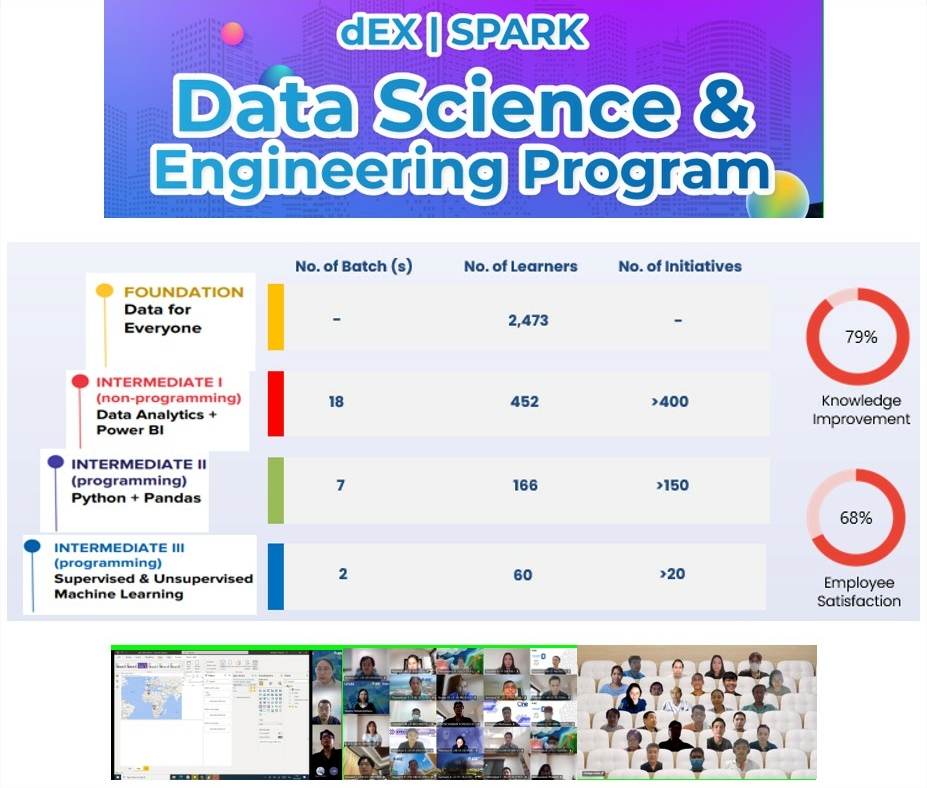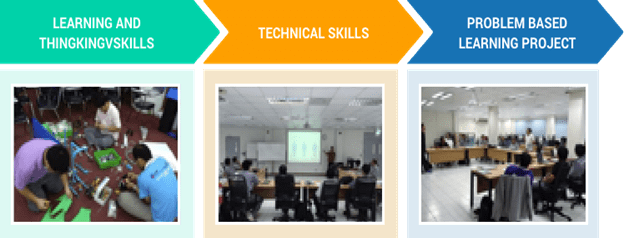Empowering Employees
GC values its employee as valuable resources, so it has drawn up a career path and launched the Learning and Development Programs for all employees, by determining the functional and leadership competencies necessary for each job position and each working level in order to develop their capability to correspond to the company’s goals and human resource development strategy. GC has also established a Succession Plan to select an appropriate replacement, who possesses necessary qualifications and is a role model in corporate culture, for each job position.
GC has developed both internal and external development programs to enhance employee capability, including coaching or mentorship, as well as team-based collaboration and network-building. These programs cover both full-time and contractual employees. The company has developed various programs such as the Leadership Development Program, Cultural Education to promote understanding and respect for diversity, the Transition Program for Retiring and Terminated Employees, and the Digital Transition Program. Example of programs from this year, including dEX | SPARK - Data Science and Engineering Program, GC Inspiration Leadership Development Program (ILP) Phase II, Global Mindset and International Business Etiquette, Happy Retirement Journey, and Productivity Improvement and Innovative Creation Training by Learning Concept of Chemical Engineering Practice School (Pi-ChEPS) Program.

Name & Description of the program
dEX | SPARK - Data Science and Engineering Program
This is a training program that was developed for employees in analyzing and processing data skills (Data Science and Engineering Program), which are applied in working and production processes.
Learning Methods
Coaching or Mentorship and Teams and Networks.
Type of Programs
Digital Transition Program.
Description of program objective/business benefits
GC has collaborated with True Digital Academy since 2021 to develop and organize the Data Science and Engineering Program for employees.
The knowledge acquired from the course can be applied to enhance GC’s data analysis and management capabilities and to leverage digital technology to support GC’s research and development. The business benefits of the program are both revenue generation and cost-saving.
From 2021 to 2024, the program welcomed over 2,400 participants. Consequently, there are more than 30 projects that are viable for actual practice.
Quantitative Impact of Business Benefits
The revenue generation and cost-saving as a result of the Data Science and Engineering Program are 59.25 million baht in 2024.
Type of workforce
Full-time Employee.
%FTE participating in the program
50%

Name & Description of the program
GC Inspirational Leadership Development Program (ILP) Phase II
This is a training program to strengthen critical leadership skills to increase productivity as a leadership role for contributing to the achievement of targeted business performance and targeted change initiative through a systematic approach for future scaling up.
Learning Methods
Coaching or Mentorship and Teams and Networks.
Type of Programs
Leadership Development Program.
Description of program objective/business benefits
The objective of this program is to build the competency of leaders from target groups.
Effective leaders foster a culture of increased productivity and decreased non-value-added (NVA) activities. Studies show companies with highly engaged employees, fostered by effective leadership, experience 21% greater profitability [Source: Gallup]. This translates to significant financial gains. Leaders can further drive applications that contribute to business impact by setting clear goals, motivating teams, and fostering collaboration [Source: Queens University]. Investing in leadership development has produced further successful initiatives such as the GC Inspirational Leader Guidebook Case Study and developing the GC Internal Instructor Pool. These efforts will lead to a more productive, profitable, and future-proof organization.
Quantitative Impact of Business Benefits
Productivity of divisions with leaders attending the program was able to reduce non-value added (NVA) activities and increase productivity.
In addition, employee engagement has improved, with 196 participants and increased cost saving 16 million baht per year by developing Internal Trainers.
Type of workforce
Full-time Employee.
%FTE participating in the program
4.5%


Name & Description of the program
Global Mindset and International Business Etiquette
This program is designed to raise awareness, understanding, and respect for diverse cultural backgrounds, practices, and perspectives. It also aims to foster mutual respect among employees, build long-term positive relationships, and enable smooth collaboration with international colleagues.
Learning Methods
Coaching or Mentorship and Teams and Networks.
Type of Programs
Cultural Education.
Description of program objective/business benefits
The company has developed an E-Learning course for all employees to help them adopt a more open and global way of thinking, known as the “Global Mindset.” This course teaches employees to embrace openness and collaborate effectively with colleagues from diverse backgrounds, including differences in ethnicity, practices, and cultural perspectives, in order to achieve business success and build sustainable credibility. Currently, more than 300 employees are continuously participating in the course.
Type of workforce
Full-time Employee.
FTE participating in the program
6.6%

Name & Description of the program
Happy Retirement Journey
This program is designed to prepare employees approaching retirement as well as those interested in physical health, financial well-being, and mental readiness, with the aim of equipping them with the knowledge to manage their post-retirement life happily and confidently.
Learning Methods
Coaching or Mentorship and Teams and Networks.
Type of Programs
Transition Program for Retiring Employees.
Description of program objective/business benefits
The company prepares employees nearing retirement through communication and education on various topics, such as explaining benefits like severance pay, provident funds, and retirement allowances. It also covers planning and managing post-retirement finances to ensure lifelong sufficiency, knowledge about physical and mental health care after retirement, and post-retirement support activities. These include promoting awareness of supplementary careers after retirement, information and rights related to social security and senior citizen welfare, to ensure that retired employees receive maximum benefits. Currently, 53 out of a total of 69 retired employees have participated in the program.
Quantitative Impact of Business Benefits
The satisfaction rating was 94.7%.
Type of workforce
Full-time Employee.
%FTE participating in the program
77%

Name & Description of the program
One Team-People Excellence GC-GCME
This employee development program for contractual staff focuses on enhancing their potential through training and knowledge-sharing, revising individual development plans, and improving work processes by integrating digital solutions. The goal is to equip contractual employees with the skills needed to effectively meet customer needs.
Learning Methods
Coaching or Mentorship and Teams and Networks.
Type of Programs
Contractual Development.
Description of program objective/business benefits
The company has developed and implemented the Turnaround – Warehouse strategy to enhance the flexibility and readiness of contractual employees in adapting to future changes in the industry. The initiative focuses on building knowledge and skills in Safety, Security, Health, and Environment (SSHE), as well as strengthening digital technology capabilities. This aims to enable employees to adopt innovative approaches in their work and deliver sustainable best practices to customers. This year, 172 contractual employees have participated in the program.
Type of workforce
Contractual.
GC is committed to promoting employee growth alongside organizational growth by offering a variety of training programs. These programs focus on developing individual potential and building new skills or reskill, especially to prepare for and mitigate negative effects of industrial or climate transition changes through various initiatives.
In 2024, the company initiated the development of the 5 Key Capabilities, emphasizing the importance of understanding industrial transformation by building skills in five core areas: Digital, Innovation, Global Acumen, Sales & Marketing, and Sustainability. The Sustainability pillar also covers the understanding of potential impacts from climate change. Employees are provided with foundational knowledge in these areas and are encouraged to apply what they learn to their work.
Furthermore, from 2025 to 2027, the company plans to further develop these five capabilities to ensure tangible outcomes in daily operations and to continuously elevate employees toward becoming solution providers and driving business impact.


Practice School (PI-ChEPS) Program The PI-ChEPS program is designed to give GC employees knowledge about chemical engineering plus the ability to use it for practical applications. Part of our company’s goal of being a learning organization, the program offers skills and processes for life-long learning.
The PI-ChEP learning process is based on a three-part constructionism concept
- The first concept is learning and thinking skills such as meditation, MicroWorlds, the GOGO Board, information searching, English, and mathematics.
- The second concept is technical skills for chemical engineering such as process science & calculation, mass & energy balance, fluid transport, heat transfer, unit operation, and measurement & control.
- The third concept is project-based learning from problems in plant operations that can improve skills in planning, analysis, and presentation by doing individual and group projects.

From 2013 to the present, the PI-ChEPS program has been implemented by applying knowledge from this program to create many projects that have been successfully implemented and can save production costs for the company continuously.
GC determines the business benefits of our investments in employee development programs by applying a third-party methodology, which is Kirkpatrick Model & Phillips ROI Methodology to measure the return on investment for training programs. It takes into account any style of training to determine aptitude based on four levels, including 1) Reaction, 2) Learning, 3) Behavior, and 4) Results. The program in 4th level of the Kirkpatrick Model are calculated Training ROI by using the Phillips ROI Methodology have four phases are 1) Evaluation Planning to develop evaluation plans and baseline data, 2) Data Collection, 3) Data Analysis to isolate the benefit of programs and covert to monetary value for using for ROI calculation, and 4) Reporting to develop report and communicate results. The Training ROI is calculated using the project benefits and costs.
Additionally, in the past year, GC has implemented the various programs to develop employee capability such as providing employee trainings through the Learning Management System (LMS), which is an online platform that encourages necessary skills development for employee operations, GC Voxy English, Application of MS Teams, and cybersecurity standard. Furthermore, GC has employed the Up Learning Platform, an online learning platform where employees can freely choose courses of their own interest. The courses had been carefully selected, taking into account the skills and academic competencies required in the current and future world to provide opportunity for employees, who want to change or develop oneself to keep up with modern skills and knowledge, to learn and apply knowledge in their work effectively.
According to our leaning and development programs, GC illustrates the employee development performance in 2024 in the figure below.
Employee Development Performance
Types of Training
| Type of Training | Average Training Hours (Hour/Person/Year) |
Average Amount Spent on Training (Baht/Person/Year) |
|---|---|---|
| Technical | 5.45 | 2,603.62 |
| Leadership | 2.59 | 4,064.46 |
| Occupational Health and Safety | 19.74 | 2,588.23 |
| Support for business for expansion | 5.13 | 2,141.81 |
| Others | 7.48 | 1,689.43 |
Average Training Hours
| Gender | Average Training Hours (Hour/Person/Year) |
Average Amount Spent on Training (Baht/Person/Year) |
|---|---|---|
| Female | 26.73 | 13,076.24 |
| Male | 45.64 | |
| Average Training Hours | 36.18 |
Investment in Employee Training
103.78 million Baht